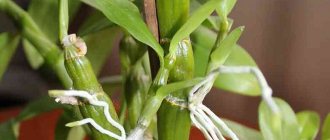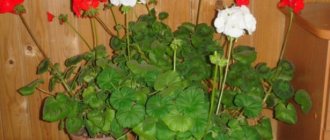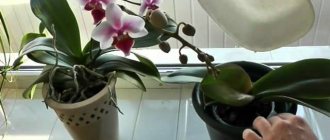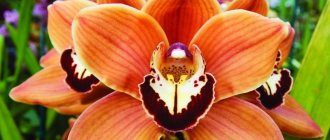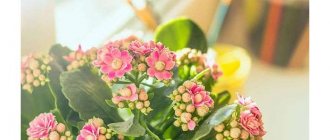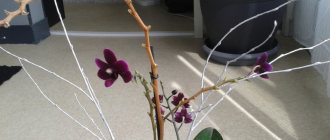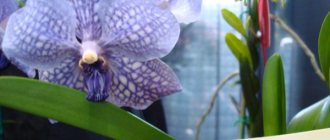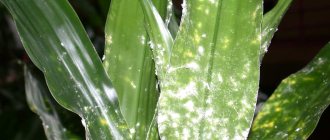WHEN TO REPLANT PHALAENOPSIS?
Replanting after purchase
Important! Phalaenopsis should be replanted immediately after purchase !
Why do you need a transplant after purchase:
1. Update the substrate.
Over time, the qualities of the substrate necessary for the growth of the orchid are lost.
Hard mineral salts accumulate and air permeability deteriorates.
2. Remove the peat (coconut) cup
Nowadays, very often there is a peat (coconut) cup or a lump of pressed moss in the roots of an orchid.
The manufacturer plants the baby phalaenopsis directly from the flask (incubator for seedlings) into a peat (coconut) cup, since babies cannot grow in clean bark.
Then they are put into pots for sale. The peat (coconut) cup is not removed, since it is impossible to immediately plant phalaenopsis in the bark after the cup (a highly moisture-intensive substrate). An orchid can die from a sudden change in substrate.
3. Inspect the roots
Orchid roots are an indicator of plant health. The transparent walls of the pot allow you to choose an orchid with a well-developed root system, but the roots are not visible inside the pot.
It is unknown how the orchid was cared for during transportation and sale in the store.
Indicators for the next phalaenopsis transplant
- The leaves begin to grow smaller than the previous ones (if you are sure that the care is normal) - this is the first indicator that it needs to be replanted.
- The salinity of the substrate depends on the hardness of the water. This is an important indicator for transplantation.
- The density of the substrate, if it has decomposed and become highly compacted.
- Different hybrids and varieties grow differently, so you need to look at them individually.
Advice! When watering with hard water, you need to replant approximately once every 2-3 years , with soft water - once every 3-4 years, or less often.
When transplanted with flowers or peduncles, phalaenopsis takes root much faster and grows roots better.
I noticed that when replanting with growing leaves, the growth of the growing leaf slows down, so I try to replant the flowering ones.
The most important thing after transplanting is to provide enough light, but not direct sun.
If during the winter months you cannot provide illumination to the orchid after replanting, then it is better not to buy or replant in December-January.
Common care mistakes
Unfortunately, every beginner and even experienced gardener has his own personal list of losses. Incorrect actions when caring for phalaenopsis at home can put an end to its development or delay the appearance of flower stalks for a long period.
What absolutely should not be done with orchids:
- Water at night. Such actions can contribute to hypothermia of the plant and cause fungal infections.
- Water with tap water. As a last resort, you can only use settled water, since the salts cover the roots, after which they will no longer be able to absorb moisture normally.
- Dilute fertilizers in arbitrary proportions. Be sure to follow the instructions.
- Place new orchids next to adapted ones. This risks infecting the entire collection.
- Keep the plant in direct sunlight. This approach will lead to burns and loss of leaves.
Which pot to choose for phalaenopsis
The first pot for transplanting phalaenopsis after purchase should be at least twice as large in volume (for mini phalaenopsis 3-4) than the one in which it was sold.
For the first transplant after purchasing an adult standard, the pot should have a volume of about 2.5 liters. It is desirable that the pot fits into the cube.
It is not advisable to use tall pots because the top will dry out and the bottom will be damp.
If you put large pieces of clean bark at 1/3 of the bottom, and then a normal substrate, then you can plant it in a tall pot.
Important! The bottom of the pot should not fit tightly to the tray.
Phalaenopsis doesn't care whether the pot is transparent or not. The main thing is that there are drainage holes in the bottom.
Transparent pots are useful for beginners. Through their walls it is convenient to monitor the condition of the root system.
But in transparent pots in the light, algae, the most dangerous blue-green algae, begin to actively grow in the substrate.
Which pots are not suitable
- Pots with holes in the sides.
Holes in the dry air of an apartment are dangerous and harmful. Roots die from drying out in the same way as from waterlogging.
After reading recommendations on the Internet, I planted my very first phalaenopsis in the same pot.
Phalaenopsis continued to bloom, but the leaves gradually began to dry out. As a result: one leaf remained, then a new one appeared, but the old one dried up. And all because the orchid did not have enough moisture and it took reserves from its leaf.
The orchid was able to emerge only after proper transplantation and proper watering.
- Flowerpots.
Phalaenopsis needs fresh air, which must move freely around the pot for ventilation.
The air in the pots is stagnant, poor ventilation, drying, humid air. This is a good environment for fungi and bacteria.
Important! You can't put the pot in a flowerpot!
Close inspection: what to look for?
Leaves and flowers
An adult phalaenopsis orchid or other species usually has several well-developed leaf blades. The presence of a young leaf, no different in length and color from the old ones, indicates the health of the flower and normal conditions of maintenance in the same place. In addition, the leaves should have excellent turgor: not droop, but grow elastically, and not look sluggish.
Visible damage or spots on the leaf blades are a reason to doubt the choice of such a plant. It is necessary to inspect the axils of the leaves - pests usually hide there and the first signs of rot appear from water entering during watering or spraying. There may also be surprises on the underside of the leaf blades - parasitic insects and their larvae are also located there.
In sympodial orchids - cattleya, cymbidium and others, the subject of inspection is pseudobulbs; they should not have soft depressed areas and spots, with the exception of species with ribbed-wrinkled tuberidia. The number of pseudobulbs less than three gives little chance of survival of the acquired plant.
If you plan to buy a blooming orchid, you should choose one with an inflorescence that has both blossoming flowers and unopened buds, which must be dense and not loose.
Roots and substrate
When examining a flower you like, special attention should be paid to the root system. If the pot of the orchid you are purchasing is transparent, it will not be difficult to see the roots: there should be no brown spots or visible areas of rot on them. The color of healthy roots is grayish or silvery-white, greenish or simply with green tips.
If, at the slightest rocking of a pot with a flower, the plant seems to dangle in it from side to side, then the root system is not in order. Healthy roots firmly hold an epiphyte in the substrate or a ground orchid in the soil mixture. The health of the purchased flower is poorly characterized by the presence of dead roots.
The condition of the substrate can also indirectly provide the grower with information about the health of the new pet. Mold or green deposits on the bark and on the inner walls of the pot clearly indicate that the orchid has been over-watered, therefore, you can expect anything from such a plant - from fungal infections to woodlice.
Transplantation process
A properly selected substrate is 60-80% of success in growing phalaenopsis.
Substrate requirements
The substrate for phalaenopsis should be:
- moisture-intensive - must take and retain moisture;
- breathable - should not cake and become dense (do not have fine dust and fine bark).
The best substrate is well-boiled pine bark (at least 16 hours), 2-3 cm in size.
If the bark is not cooked , it does not absorb and retain moisture well. Therefore, you need to add chopped sphagnum moss (30% by volume).
The bark is cut into pieces with pruning shears:
- For adolescent phalaenopsis, the optimal fraction size is 1–1.5 cm.
- For adult specimens, prepare pieces of 2.5–3 cm.
You can read about bark and sphagnum moss in the article “Substrate for orchids.”
Preparatory stage
Before transplanting, soak the bark in water at room temperature for 4-5 days. Then drain the water (no need to dry).
Important! You cannot plant phalaenopsis immediately after a moisture-intensive substrate in clean bark!
Before transplanting, the orchid needs to be watered . The roots will become more elastic and will easily tuck into the pot.
Carefully remove the orchid from the pot, lightly shake off the old substrate that has grown in - do not tear it off .
Inspection of the root system
It is necessary to check the root system of phalaenopsis. Dry, wrinkled roots, as well as threads without velamen, rotten, should be removed.
Important! Do not wash the roots before planting!
All roots should be dense, without blackness or soft wet spots.
Normally, the roots of phalaenopsis are dense, white or yellowish in color; when moistened, they acquire a green color.
If there was pruning or stripping, then dry it for a couple of hours before planting .
Preventative treatment
If there is wet rot on the orchids, they need to be cleaned to the living thing and treated with systemic fungicides : foundationazol (benomyl) or Previkur.
If the stains are local , then make a paste of foundationazole and coat it. If you need to spray or soak the entire plant, then dilute 5-10 g of foundationazole in 1 liter of water.
Transfer
At the bottom of the pot, about 1/4-1/3, put large bark.
Important ! Phalaenopsis should be planted a moist substrate and watered immediately or the next day, but no later.
Align the orchid vertically in the center of the pot.
Do not compact the substrate , but pour it in parts between the roots, tapping the wall of the pot with your palm.
Important! be no substrate in the leaf axils !
When replanting, you need to fall asleep right under the leaves , that is, deepen the orchid.
Why do you need to remove the lower leaves and plant in a hole?
Because new roots are important , which will grow in your conditions and will be adapted to them.
If the lower leaves get in the way (when the roots grow high above the lower leaves), then the leaves are torn off without leaving any residue.
Important! should be remains of dried on the phalaenopsis stem .
Leaves are removed as follows: cut the leaf along the longitudinal vein and tear it off in different directions from the base.
When replanting phalaenopsis with flowers or with peduncles, the orchid takes root faster and grows roots better.
Video from manufacturers about proper transplantation.
Varieties of orchids
Varieties of Phalaenopsis orchids differ from each other in color, leaf shape and size of the flower itself. This variety grows on a short stem with a rosette of 5 leaves. Almost all 100 varieties of phalaenopsis are hybrid.
Phalaenopsis pleasant is a common variety with fleshy leaves that are oval shaped and have a pointed tip. On the released inflorescence you can count about 30 buds, which bloom one by one.
Interesting! If you properly care for this variety of phalaenopsis and cut off faded flowers in time, the entire flowering period can last a whole year.
Parisha is a miniature Phalaenopsis with a peduncle bearing approximately 10 white flowers with a sweet, fruity scent.
Hieroglyphic phalaenopsis is a large flower whose rosette consists of oval leaves and many star-shaped flowers. The blooms are painted in white and cream tones with greenish edges.
Horse Phalaenopsis is a variety with bright purple flowers, they are only 2-3 cm in size. When the plant blooms, its peduncle becomes longer and new ones grow in place of withered buds, so the variety continues to bloom for several months.
Care after transplant
The most important thing after transplanting is to give enough light, but not direct sun .
After planting , water immediately or the next day, but not later.
If during the winter months you cannot provide light to the orchid after transplantation, then it is better not to buy it.
If transplanted correctly, the orchid should not notice this. There should be no wilting of leaves or dropping of flowers.
Reasons for leaf wilting after transplantation
1. Not enough moisture.
There may be a lack of moisture for two reasons:
- insufficient watering or the substrate does not take up water (fresh living bark);
- lack of roots (rotten, dried out).
2. If the orchid is placed in the sun after transplantation .
Yellowing of leaves
It is normal if the bottom leaf turns yellow at the end or evenly . A leaf that has turned yellow at the end must be removed, tearing it off completely when it has turned 2/3 yellow.
If the leaf turns yellow from the stem , then most likely the stem is rotting . If the leaf turns yellow from the stem, remove it immediately and look at what’s wrong with the stem. If it rots, then clean it and treat it with fungicides.
Causes of drying buds and flowers
The main reasons for the drying (withering) of flowers and buds:
1. Lack of light.
2. Lack of moisture and overdrying. If there is a lack of moisture, photosynthesis cannot proceed normally, the orchid cannot flower, and therefore drops its flowers.
3. Excessive sun exposure to the orchid and its flowers.
4. The orchid gets exposed to cold frosty air from the window when ventilating.
5. Pests.
What to do with an orchid immediately after purchase
Today, phalaenopsis is sold in every flower shop and garden center.
The variety of orchid varieties is amazing. Flowers can be either large or belong to the group of miniature plants. On sale there are phalaenopsis with white, yellow, pink, crimson, and speckled petals. There is plenty to choose from. Unfortunately, orchids in the store do not receive proper care. Often the plants are overdried or, on the contrary, flooded; pests (spider mites, scale insects, scale insects) can hide among the leaves and in the substrate.
For the first 2 weeks after purchase, the orchid is kept in quarantine, placing it away from other indoor plants, ideally on a separate windowsill. If during this time the presence of harmful insects is not detected, you can move the flower to the place where you plan to keep it. Phalaenopsis needs time to adapt, which should take place in gentle conditions.
On a note! Orchids are usually sold in pots filled with pine bark. If the pieces of bark do not have a putrid odor, which often happens when flooded, the plant can be kept in this substrate for a long time (more than a year).
Caring for a newly purchased plant depends on its condition. The flooded orchid is kept without watering until the substrate dries out. The dried flower is given a bath, soaking it together with the pot in settled water for 20-30 minutes. Then the remaining moisture is allowed to drain and the orchid is placed in a bright, warm place.
What you need to know about transplanting phalaenopsis at home
For a painless flower transplant, you need to follow certain rules.
It is advisable to replant the orchid during the dormant period, that is, in early spring or autumn . However, since the root system of the flower is not sensitive to pruning, it is not necessary to strictly adhere to this rule. If necessary, the plant can be replanted at the flowering stage, but before the procedure, all flower stalks should be cut off by 2 cm. This will help speed up the growth of new root mass and will also promote the formation of lateral flower stalks.
Many gardeners wonder: is it necessary to replant an orchid immediately after purchase? This is necessary if its roots look pale and wrinkled. Such consequences are caused by spraying with drugs that stimulate the flowering process. The plant is subjected to this treatment in nurseries, but the procedure produces a side effect: it leads to depletion of the root system. If such signs are present, the affected plant is replanted after acquisition; in other cases, there is no need for replantation .
Rules for choosing a pot for an epiphyte
The success of flower growth depends on the choice of pot.
An orchid is a rather capricious flower that reacts to even the smallest imperfections in growing conditions. Therefore, it is worth paying attention to the features of the container where you plan to transplant the plant.
The requirements for the pot are as follows:
- The container for the plant is selected 3–5 cm larger than the previous pot.
- The most suitable option is a plastic container. The orchid root system takes part in photosynthesis, so the plant needs light and good air access.
- The pot should have several ventilation holes. You can make holes in a plastic container yourself.
- Glass planters provide unlimited access to light, but make aeration difficult due to the lack of ventilation holes. Such pots are still used for orchids, but watering the flower will be more labor-intensive, since you will have to carefully monitor the drainage of excess moisture (to avoid rotting of the roots).
- For orchids, clay pots can also be used. But flower growers recommend choosing plastic and glass materials. This is due to the fact that clay containers do not transmit light. And also the walls of such pots have an uneven surface. The roots of the flower can grow into the ceramic material and will inevitably be injured during transplantation .
